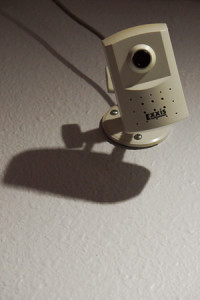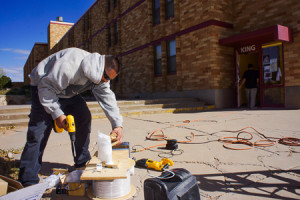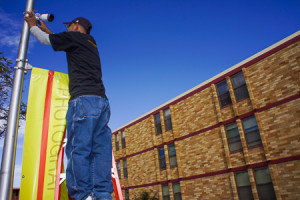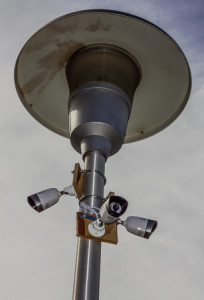Tags
Related Posts
Share This
Surveying Surveillance

The University is in the process of upgrading and expanding the use of security cameras in an effort to improve campus security. Photo by Luke E. Montavon/The Jackalope
A second incident involving a female student encountering an unknown male in a dormitory bathroom has steeled the resolve for enhanced campus surveillance.
At the start of the 2015 fall semester, the campus will be monitored and recorded 24/7 by nearly 50 security cameras, according to Director of Facilities and Security Peter Romero.
The new cameras are part of a two-phase plan, which Romero said was conceived last summer in response to the recent addition of the Higher Learning Center, and a marked increase in the student population.
“I think this is a positive step to continue security improvements on campus for [everyone],” Romero said.
Though campus surveillance has been a source of contention at some universities, students at Santa Fe University of Art and Design seem to be the new camera plan’s greatest champions.
“Things have to change around here,” Jordyn Aquino said, “the safety of my peers is very important to me.”
Aquino is a musical theater major and one of the camera plan’s more active proponents. After learning about the sexual assault that took place Oct. 2 in a dormitory bathroom and hallway, she posted a Facebook status on the Student Life page in which she solicited help to draft a petition for more security cameras.
“It scares me and angers me that a sexual predator may be roaming our campus because we did not have the proper evidence to convict him,” Aquino said.
The only suspect arrested in the Oct. 2 assault was released from police custody, and allowed back on campus, according to a previous Jackalope Magazine article.
The second incident occurred on Oct. 30. According to a campus-wide email from Senior Director of Student Life Laura Nunnelly, “a female student contacted campus security to report an incident involving an unknown male in the female bathroom of King Hall.” According to the email, campus security was searching for the suspect, and the Santa Fe Police were contacted. No further information was available at the time this article was published.

Left, Daniel Gutierrez of IT Connect prepares one of a dozen new surveillance cameras for installation outside of King Hall on Friday October 31, 2014. Photo by Luke E. Montavon/The Jackalope
Familiar with the predation of catcalling while traversing campus property, Aquino said she would like to see cameras both indoors and outdoors on every entrance, exit, public space and courtyard, including “the hallways [and] stairways of dorms.”
“I understand that this is controversial,” she said, acknowledging privacy concerns, “but [students] need to really consider … that there are victims living on our campus who are in a perpetual state of fear and discomfort because their attacker is still at large.”
To some extent, photo major Forrest Soper agrees with Aquino.
“I know that due to the recent incident on campus, many individuals feel unsafe and are pushing for the installation of new cameras,” he said, “and I have absolutely no problem with that.”
However, Soper also said he has never liked the idea of surveillance, even if only used for the purpose of verifying criminal activity. In fact, when asked in an informal Jackalope-sponsored Facebook survey if he was for, against or undecided in regard to the new camera plan, Soper was the only student out 58 respondents to choose against—49 were for, and eight were undecided.
“I have never felt that security cameras or surveillance systems made me feel safe.”
Because he lives off campus and was not affected by the assault, Soper said he does not want to speak out against what other students may perceive as a means to reassurance and safety, and therefore, supports their desire for additional surveillance.
David Roth, although he did not respond to the survey, also is an opponent of Aquino’s effort and the camera plan.

Freddie Gutierrez of IT Connect installs one of a dozen security cameras outside of King Hall on Friday October 31, 2014. Photo by Luke E. Montavon/The Jackalope
When commenting on her petition post, he said cameras monitoring dormitory hallways would be an “invasion of privacy,” and that security should be more diverse and even-handed in their tactics when combating campus crime, e.g., offering self-defense classes, investigatory follow-ups on theft complaints and more student-ID checking.
Though, agreeing with Aquino on one point, Roth said, “I do think additional surveillance should be installed, [but] at the entrances of each dorm,” adding that this could act as a deterrent for an individual considering a criminal act.
But, the prospect of SFUAD’s 49 cameras pales in comparison to University of Kentucky’s $5 million, 2,000 camera upgrade for its 30,000 students.
According to the Huffington Post, this overhaul drew the attention of the America Civil Liberties Union along with its privacy concerns, which reflected those of Roth’s. Mainly, an ACLU spokeswoman told the Post, the organization was concerned with information being gathered and stored on what they consider to be innocent people.
“We are only using the cameras as a safety tool,” Romero said.
The new cameras, according to Romero, will be digital, and capture images in high definition.
Also, surveillance data will be stored on a campus server one year before it’s automatically deleted, but not before it’s copied onto a compact disc and stored for another seven years, after which the CD is destroyed.
How accessible surveillance data would be to unauthorized users, Romero could not say with any certainty. However those who will have authorized data access, other than Romero, include President Larry Hinz, Human Resource Director Todd Spilman and Safety and Security Manager Larry Samuel.
Romero said he has no plans to install additional surveillance equipment in any residential hallway.
Phase one of the plan should be completed by the end of the fall 2014 semester, and will include installation of “several outdoor cameras that will pan, tilt and zoom,” while phase two, Romero said, should be completed by the end of spring 2015, which will add “cameras to several doors in the dorm areas.”

In light of more recent events, a dozen security cameras have been installed outside of King Hall as of Friday October 31, 2014. Photo by Luke E. Montavon/The Jackalope
Camera plan information requested, but not available to the public, included, Romero said, any new security procedures being enacted in conjunction with the surveillance upgrade, and the amount of money spent in total on hardware and labor.
The student who was the target of the Oct. 2 assault said she’s “grateful” for the new camera plan, and that campus safety will improve as a result.
“I don’t feel safe at all,” she said.
Having driven to the Jackalope interview, which took place in the film building, because she was too afraid to walk the approximately 100 yards from King Hall, she said, “I drive everywhere because he’s still on campus.”
She mentioned how what happened to her could happen to someone else, but “if there’s cameras in the hallway,” she said, “we could found out who he is.”






 Jackalope Magazine is the student magazine of Santa Fe University of Art and Design. Building on the interdisciplinary nature of our education, we aim to showcase the talent of our university and character of our city.
Jackalope Magazine is the student magazine of Santa Fe University of Art and Design. Building on the interdisciplinary nature of our education, we aim to showcase the talent of our university and character of our city.
Recent Comments